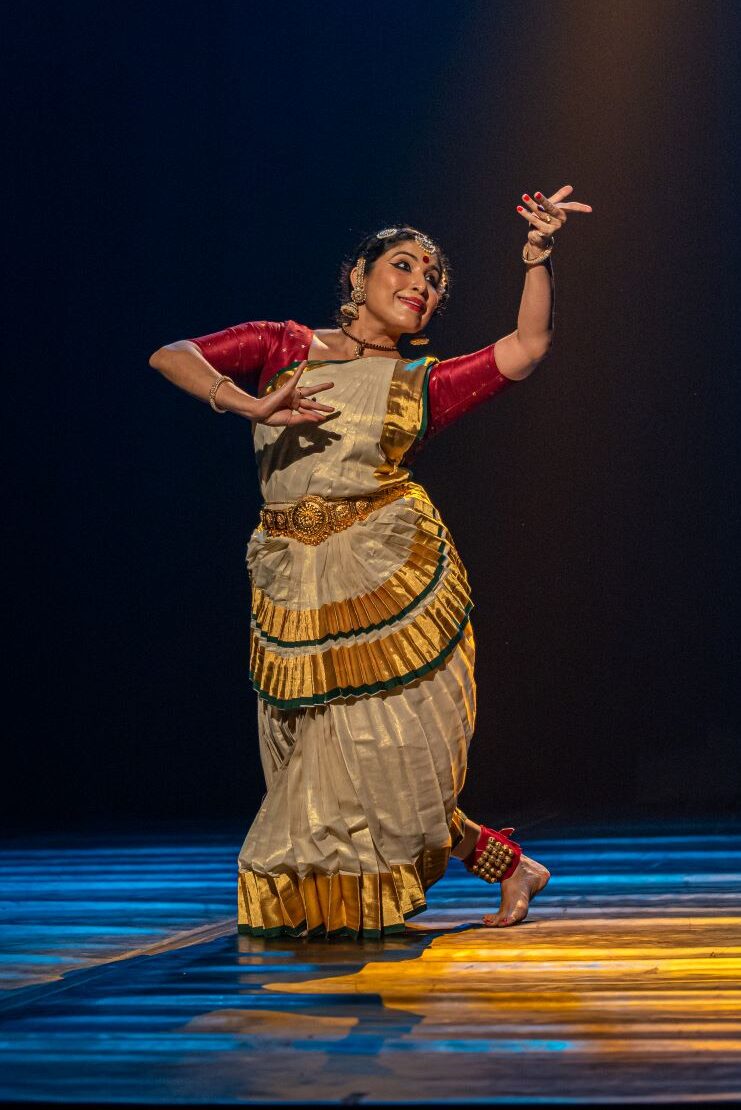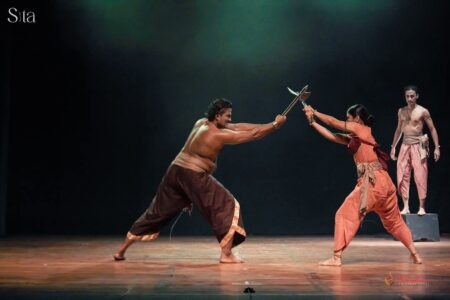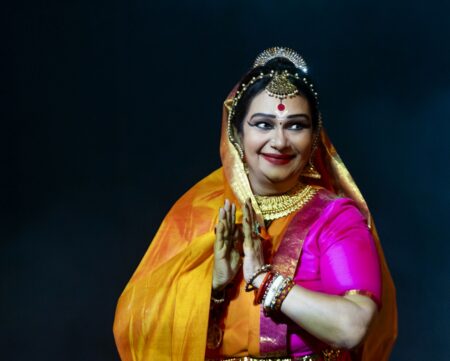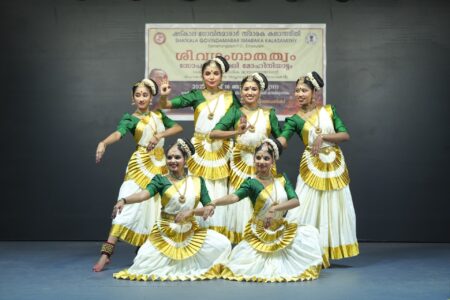The recent Mohiniyattam programme, Samyati, was a visual treat for the audiences in India’s IT capital.
The morning sun in Bangalore struggled to creep into the performance space at Medai, Koramangala. The stage is dark, except for a spotlight that hovers around before illuminating a small idol of Nataraja in the front corner. The vibrating sound of a conch pierces the silence as the stage softly lights up. Four performers enter, each holding a palm full of flowers, and offer them to the idol. They occupy four corners of the centre stage as the music flows in Guru Brahma Guru Vishnu…Thus, Samyati begins.
The first chapter of the event, “Samyati: The Free Spirit of Art”, showcased popular choreographies of Mohiniyattam guru Nirmala Paniker. Comprising four solo performances, the event featured Anju Peter, Ameena Shanavas, Keiko Okano, and Shruthi K P. Disciples of Nirmala Paniker and disciplined in Navarasa Sadhana as propounded by Venu G, these alma-maters of a Natanakaisiki strung together two hours of visual treat.
Anju’s surrendering to Krishna
Samyati began with Anju Peter’s depiction of the varnam, Geetha Othiya Govindhan. A narrative thread of bhakti runs through this piece, which depicts tales of Krishna’s deliverance to his loved ones. Beginning with depicting Geetopadesham, Anju seamlessly transitions between a distraught Arjuna and a compassionate Krishna. The well-executed interplay between music and verses from Bhagavat Gita accentuated Anju Peter’s portrayal of Krishna’s immense persona and Arjuna’s awe.

The varnam picked pace with Draupadi’s disrobing, enacted through the perspectives of three central characters – Draupadi, Dushasana and Krishna. While it followed a traditional interpretation of Draupadi’s plight, Anju’s exploration of the multiple emotional tangents within Draupadi’s character sent empathetic chills upon the audience, thus leaving a lasting impact.
The charanam section, where the ten incarnations of Vishnu were embodied, was captivating. Anju’s depiction of Narasimha – the cross-eyed, tongue-bulged, half-human, half-animal form, drinking and licking blood – was particularly striking. While the ending had an emotional peak of bhakti, with the narrator witnessing multiple manifestations of the Lord, it fell short of Anju’s earlier emotive brilliance. Her performance, with her movement finesse and skilled abhinaya set the tone for the rest of the performances.
Ameena blissfully dancing as Shiva
In the second performance, Ameena Shanavas performed a varnam praising Shiva, Natananipuna, written by Nirmala Paniker. Integrating pure dance and storytelling, it depicted two tales – the destruction of Kama Deva and Shiva becoming Neelakanda. From the start, Ameena showcased an impressive ability to flow with her body movements. The opening story was the destruction of Kamadeva into ashes. Although Shiva’s wrath is often intensely portrayed in classical dances, Ameena’s depiction of fury felt nuanced with careful eye and facial muscle movements, yet subtle and mellow. The abhinaya peaked in the narrative of Shiva consuming poison. The changing actions involving Shiva, Parvathi, and Vishnu had a dramatic essence that kept the audience engaged.

The most captivating moment of the piece is when Shiva is strangled by both Parvati and Vishnu. Before fainting, there is a brief moment of silence with no music, with just a faint breath of the performer resounding in the front rows. The impact the silence created was palpable. The following charanam, where Ameena breaks into Shiva dancing to the beats of the damaru, is a blissful portion to watch.
Keiko’s wanderings as Kurathi
Next, Keiko Okano performed Kurathi from the desi repertoire of Nirmala Paniker. With the nomadic Kurathi as the narrator, the performance felt like an engaging conversation. Right from the outset, Keiko showcased exceptional command over her body and eye movements. The delightful playfulness of this character was vividly portrayed in the palm reading sequence where the Kurathi predicts the fate of a lovelorn woman.

In the following segment, Kurathi recounted the tale of Vishnu manifesting as Mohini and Shiva being attracted, leading to Ayyappa’s birth. The mood of devotion intensifies with Keiko depicting the indigenous rituals associated with a devotee visiting Ayyappa at Sabarimala. This section struck the right chord of relatability and bhakti. Surprisingly, the mood changed from bhakti with the Kurathi playfully reasserting her narratorial role and taking leave from the audience members before ending the piece.
This performance felt like a fresh breath of air. The regionality in the lyrics, music and storyline enhanced the liveliness of the performance. Although a popular choreography, pieces of which are available online, the re-watchability is a testament to the choreography’s uniqueness and the performer’s calculated yet surrendering movements and abhinaya.
Shruthi and the Mookuthi
As the finale performance, Mookuthi, from the desi repertoire, was performed by Shruthi KP. This item began with a simple question – have you seen my nose stud? Before diving into a relentless search for it, there is a moment of reminiscence with the performer, enacting how other women had admired the stud. Coupling symbolic descriptions and nuanced eye movements, Shruthi visualises the alluring charm of this nose stud. It was truly mesmerising to witness the ease with which Shruthi brought the audience on board in this imaginative quest.

While the subsequent adavus revealed a hint of physical exhaustion on Shruthi’s part, the ensuing spiritual search made up for it. Small moments exemplified the emotional depth of Shruthi’s understanding and expression of an inner awakening. Must mention are the use of an actual mirror, the trance-like spirals and the frozen expression of looking within oneself. As in Natananipuna, the dramatic pause of music with Shruthi reaching the zenith of her spiritual search resulted in a cathartic experience for the audience. Shruthi owned the stage with her natural abhinaya. The piece ended on a serene and content note, with a meditative posture and om chants unfurling – a fitting conclusion to the saptham and Samyati.
Samyati, travelling through space and time
Samyati was a reminder that dance transverses space and time. The four performances stood out for their exceptional storytelling techniques and finesse in emotive expression. The event transversed through mythological tales in the varnam and folklore narratives in the saptham. Perhaps altering between the varnam and desi items would have made it easier for the audience to appreciate each piece as an individual entity better.
Each piece was introduced with gestural narration by a dancer (who was not performing the respective piece) and a pre-recorded English voice-over This thoughtful approach allowed everyone to plunge into the performance without prior knowledge of the language or dance form. One minor improvement could have been in ensuring that the background music during the voice-over was sustained until the narrator left the stage and the performer took their place, resulting in a more seamless transition of the piece from one performer to another.
The performances received significant support from pre-recorded music and aptly envisioned lighting. The gradual transitioning of hues reflective of emotions added to the overall experience.




